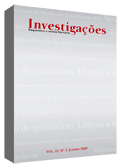Variação e mudança na sintaxe como competição de gramáticas
Abstract
Discuto, neste artigo, um modelo teórico para o estudo da mudança sintática viacompetição de gramática (Kroch 1989). Defendo que o estudo da variação e mudançasintática, nessa perspectiva, estabelece um ponto de diálogo entre a observaçãoempírica na gradação de formas variantes no curso do tempo, num ambienteheterogêneo (Weinreich, Labov e Herzog 1968; Labov 1982) e a análise explicativada teoria da gramática.References
BARBOSA, Pilar. 2000. Clitics: a window into the Null Subjetc Property. In: João Costa (ed). Portuguese syntax – new comparative studies. Oxford: University Press, pp. 31-93.
CARNEIRO, Zenaide de Oliveira Novais. 2005. Cartas brasileiras (1809-1904): um estudo linguístico-filológico. Tese de Doutorado. UNICAMP.
CHOMSKY, Noam. 1981. Lectures on government and binding. Dordrecht: Foris.
______. 1986. Knowledge of language: Its nature, origin and use. New York: Praeger.
CYRINO, Sonia. 2007. Mudança sintática e português Brasileiro. In: CASTILHO, Ataliba; TORRES MORAIS, Maria Aparecida; LOPES, Ruth & CYRINO, Sonia (org.). Descrição, história e aquisição do português brasileiro. Campinas: Pontes. pp. 361-373.
GALVES, Charlotte. 2004. Padrões rítmicos, fixação de parâmetros e mudança linguística – Fase II. UNICAMP CAMPINAS. (Projeto de pesquisa FAPESP).
GALVES, Charlotte; TORRES MORAIS, Maria Aparecida; RIBEIRO, Ilza. 2005. Syntax and Morphology in the placement of clitics in European and BrazilianPortuguese. Jornal of Portuguese Linguistics, vol. 4, nº2, Studies in the comparativesyntax of European and Brazilian Portuguese, pp. 143-177.
GALVES, Charlotte; BRITTO, Helena; PAIXÃO DE SOUSA, Maria Clara. 2005. The Change in Clitic placement from Classical to Modern European Portuguese: Results from the Tycho Brahe Corpus. Journal of Portuguese Linguistics, Vol. 4, n.1,Special Issue on variation and change in the Iberian languages: the Peninsula and beyond, pp. 39-67.
HUBER, Joseph. 2006. Gramática do Português Antigo. 2ª edição – tradução de Maria Gouveia Delilie. Lisboa: Fundação Calouste Gulbenkian. [1933]
KROCH, Anthony. 1989. Reflexes of Grammar in Patterns of Language Change. Language Variations and Change, (1):199-244.
______. 2001. Syntactic Change. In. Baltin & Collins (eds.). The handbook of contemporary syntactic theory. Massachusetts. USA: BlackWell, pp. 699-729.
______. 2003. Mudança sintática. «http://www.ling.upenn.edu/ kroch». Traduzido por Silvia Cavalcante.
______; TAYLOR, Ann. 1997. Verb Movement in Old and Middle English:
dialect variation and language contact. In: KEMENADE, A.Van & VINCENT, N. (orgs.), Parameters of morphosyntactic change. Cambridge: Cambridge University Press, pp.297-325.
LABOV, William. 1972. Sociolinguistic Patterns. Philadelphia: University of
Pennsylvania Press.
______. 1978. Where does the linguistic variable stop? A response to Beatriz Lavandera. Working Papers in Sociolinguistics 44.
______. 1982. Building on empirical foundations. In: Lehmann , Winfred
P. & Malkiel, Yakov (eds.). Perspectives on Historical Linguistics. Amsterdam/ Philadelphia: John Benjamins, pp. 17-92.
LAVANDERA, Beatriz. 1978. Where does the sociolinguistic variable stop? Language in Society (7):82-171.
LIGHTFOOT, David. 1999. The development of language: Acquisition, change, and evolution. Malden: Blackwell/Maryland lectures in language and cognition.
LOBO, Tânia. 1992. A colocação dos clíticos em Português. Duas sincronias em Confronto. Dissertação de Mestrado. Universidade de Lisboa, Faculdade de Letras.
MARTINS, Ana Maria. 1994. Clíticos na história do português. Tese de doutoramento, Universidade de Lisboa, Faculdade de Letras.
MARTINS, Marco Antonio. 2009. Competição de gramáticas do português na escrita catarinense dos séculos 19 e 20. Tese de Doutorado, Programa de pós-graduação em Linguística/UFSC.
MATTOS E SILVA, Rosa Virgínia. 2008. Caminhos da Linguística Histórica – ouvir o inaudível. São Paulo: Parábola Editorial.
______. 2006. O português arcaico – fonologia, morfologia e sintaxe. São Paulo: Contexto.
MILROY, Lesley & GORDON, Matthew. 2003. Sociolinguistics: method and
interpretation. Oxford: Blackwell Publishing.
PAIXÃO DE SOUSA, Maria Clara. 2004. Língua Barroca: Sintaxe e História do português nos 1600. Tese de doutoramento, Campinas: IEL/UNICAMP.
______. 2006. Linguística Histórica. In: Pfeiffer , Claudia Catellanos &
Nunes, José Horta (orgs.). Introdução às ciências da linguagem – Linguagem, história e conhecimento. Campinas: Pontes, pp. 11-48.
PAGOTTO, Emilio Gozze. 1992. A posição dos Clíticos em Português. Um estudo Diacrônico. Dissertação de mestrado, Universidade de Campinas.
WEINER, Judith; LABOV, William. 1983. Constraints on the agentless passive. Journal of linguistics (19):29-58.
WEINREICH, Uriel; LABOV, William; HERZOG, Marvin. 1968. Empirical
foundations for a theory of language change. In: Lehmann, Winfred P. &
Malkiel, Yakov (eds.). Directions for Historical Linguistics. Austin: University of Texas, pp.95-188
Downloads
Published
How to Cite
Issue
Section
License
Copyright (c) 2015 Marco Antônio Martins

This work is licensed under a Creative Commons Attribution 4.0 International License.
Authors who publish with Revista Investigações agree to the following terms:
Authors retain copyright and grant the journal right of first publication with the work simultaneously licensed under the Creative Commons Attribution 4.0 International (CC BY 4.0) license that allows others to share the work with an acknowledgement of the work's authorship and initial publication in this journal.
Authors are able to enter into separate, additional contractual arrangements for the non-exclusive distribution of the journal's published version of the work (e.g., post it to an institutional repository or publish it in a book), with an acknowledgement of its initial publication in this journal.
You are free to:
Share — copy and redistribute the material in any medium or format for any purpose, even commercially.
Adapt — remix, transform, and build upon the material for any purpose, even commercially.
The licensor cannot revoke these freedoms as long as you follow the license terms.
Under the following terms:
Attribution — You must give appropriate credit , provide a link to the license, and indicate if changes were made . You may do so in any reasonable manner, but not in any way that suggests the licensor endorses you or your use.
No additional restrictions — You may not apply legal terms or technological measures that legally restrict others from doing anything the license permits.

